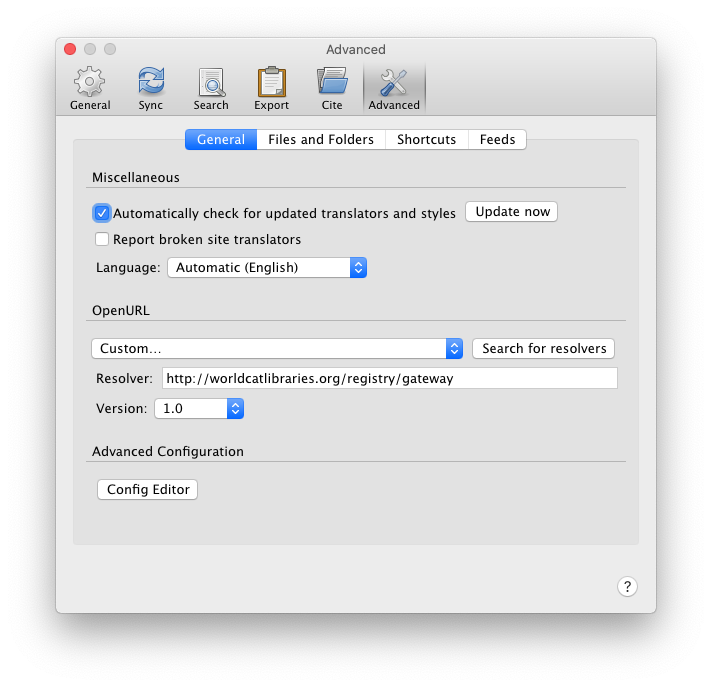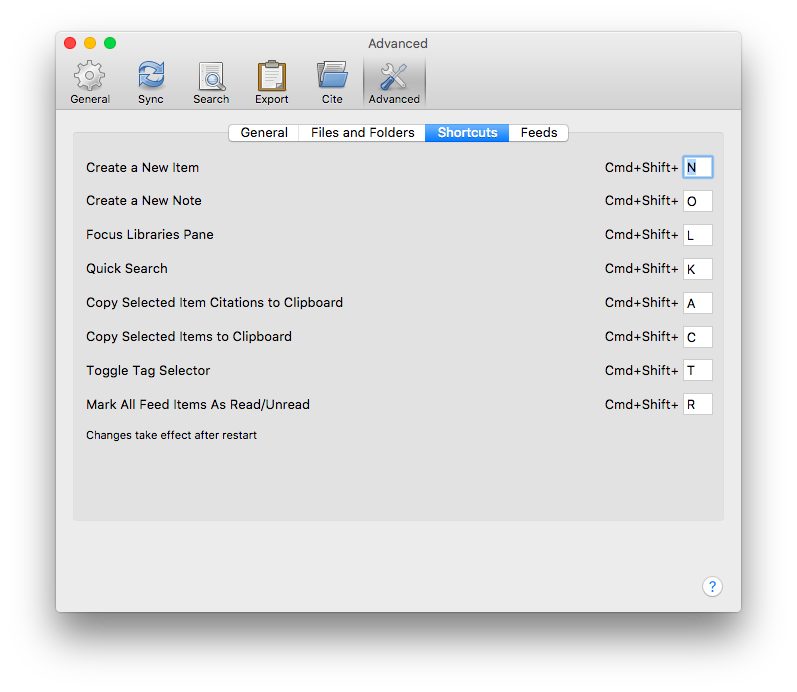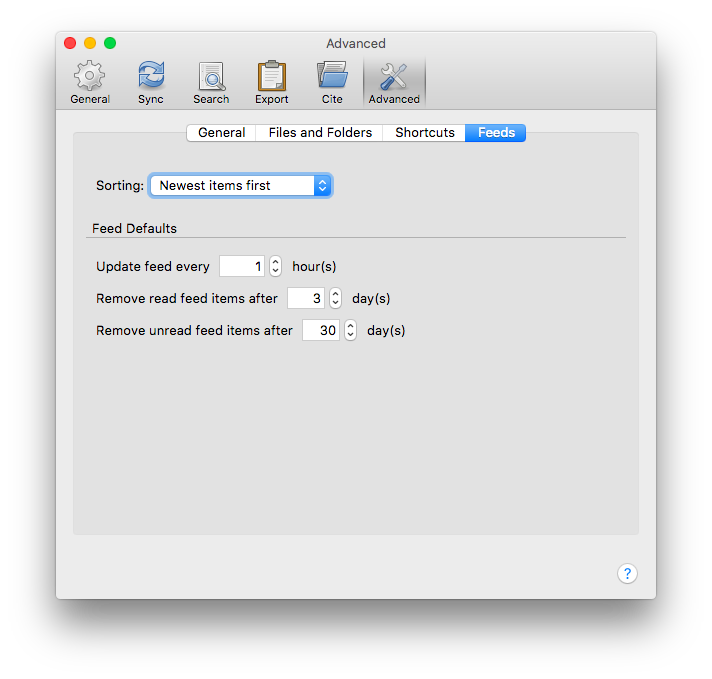This is an old revision of the document!
Advanced
The Advanced pane has four tabs: “General”, “Files and Folders”, “Shortcuts”, and “Feeds”.
General

Language
Set the language for the Zotero interface.
OpenURL
Here you can specify a different OpenURL resolver for use with Zotero's Library Lookup feature.
If you are on an institution network, you can click the “Search for resolvers” button. If Zotero finds an OpenURL resolver belonging to your institution, you can select it using the “Custom…” drop-down menu.
You can also enter an OpenURL URL by hand in the Resolver field. Most resolvers use OpenURL version 1.0, but 0.1 is still in use. Ask your librarian for more information, or check our own list of OpenURL resolvers.
Advanced Configuration
Click the “Config Editor” button to configure Zotero's hidden preferences.
Files and Folders

Linked Attachment Base Directory
If you store attached files in Zotero — the default — this setting does not affect you. It only applies to linked files.
This setting allows you to specify a base directory for linked files, so that links are functional on two computers with different directory structures (e.g., when a folder with linked files is synced through a service like Dropbox). For example, if the folder with your linked files is at /home/laptop/sync on your laptop and at /home/work/sync on your work computer, set those paths as the base directory on each respective machine. Zotero then only stores the links relative to that base directory, so the same “relative” links work on both computers.
Data Directory Location
By default, Zotero stores your data directory (which contains your library database, attachment files, and several other files) in your user home directory on your computer. This is the best location for most users, but it is possible to change the location. After changing the data directory location, Zotero will store newly created data in the new location.
Note, that Zotero will not, however, copy over existing data to the new location. If you want to keep your data, you need to move the files manually. Click the “Show Data Directory” button to open the Zotero directory in your computer's file browser. You will need to move the entire “Zotero” folder (including, 'zotero.sqlite', 'storage', 'styles', and all other files) to the new directory.
If you're using auto-syncing, you may want to disable it temporarily from the Sync pane of the Zotero preferences before changing the data directory. Otherwise, if you accidentally start Zotero with the wrong data directory set or before moving data, Zotero will attempt to pull down your entire library from the server.
Unsafe Data Directory Locations
There are several data directory locations that are potentially unsafe and likely to lead to database corruption or even data loss. If you use any of these setups, be sure to back up your Zotero data frequently.
- Cloud-syncing folders: Storing your Zotero data directory in a cloud-syncing folder (e.g., Dropbox, Google Drive, or other similar folder synchronization services) is extremely unsafe and will almost certainly lead to database corruption and potentially data loss. The forums contain several threads about the problems that users have faced with Dropbox- or Google Drive-based setups. See Alternative Syncing Solutions for potential safe methods of using cloud-syncing services to sync Zotero attachment files.
- Network drives: If you store your Zotero data directory on a network drive and then access it from multiple computers at the same time, you are very likely to encounter database corruption. For example, if you leave Zotero open on your laptop, then open the same Zotero database on the network drive from your work computer, you will likely experience corruption. You should never use a network drive to permit multiple users to access the same Zotero database on different machines (use Groups or Zotero syncing for that).
- Virtual machines: Similar to issues with network drives, it can be unsafe to use the same Zotero database file from both a virtual machine and the computer's host operating system (or another virtual machine). If the same Zotero database is accessed from two locations at the same time (e.g., if Zotero is open on both the virtual machine and the host operating system), corruption is likely. If you want to use Zotero in a virtual machine, it is better to set up a separate Zotero data directory in the virtual machine and to keep it up to date using Zotero syncing.
Database Maintenance
- Check Database Integrity: This function checks your Zotero database for any data corruption. Database corruption is rare. In most cases, it is caused by storing your data directory in an unsafe location. Checking database integrity can take a long time if your database is very large. If your database is corrupted, you can use the Database Repair Tools to repair the corruption.
- Reset Translators…: Reset web and import/export translators to the current Zotero defaults using the latest versions from the Zotero server.
- Reset Styles…: Reset citation styles to the current Zotero defaults using the latest versions from the Zotero server.
Shortcuts

This tab allows you to change Zotero's default keyboard shortcuts.
- Create a New Item: Create a new blank item in the current collection.
- Create a New Note: Create a new standalone note in the current collection.
- Focus Libraries Pane: Sets the focus in Zotero to left (libraries, collections, and feeds) pane.
- Quick Search: Sets the focus to the Quick search box.
Ctrl/Cmd-Fwill also focus the Quick search box. - Copy Selected Item Citations to Clipboard: Copies an inline citation for the selected item(s) to the clipboard. (Depending on the style, this could be long and detailed or, if the style demands footnotes, simply a number.)
- Copy Selected Items to Clipboard: Copies the full bibliographic reference for the selected item(s) to the clipboard.
- Toggle Tag Selector: Shows/hides the tag selector.
- Mark All Feed Items As Read/Unread: Marks all items in the selected feed as read/unread.
Any changes made to this page will only take effect after you restart Zotero. a new browser window is opened.
Windows Defaults
| Function | Command |
|---|---|
| Create a New Item | Ctrl-Shift-N |
| Create a New Note | Ctrl-Shift-O |
| Focus Libraries Pane | Ctrl-Shift-L |
| Quick Search | Ctrl-Shift-K |
| Copy Selected Item Citations to Clipboard | Ctrl-Shift-A |
| Copy Selected Items to Clipboard | Ctrl-Shift-C |
| Toggle Tag Selector | Ctrl-Shift-T |
| Mark All Feed Items As Read/Unread | Ctrl-Shift-R |
Mac OS X Defaults
| Function | Command |
|---|---|
| Create a New Item | Cmd-Shift-N |
| Create a New Note | Cmd-Shift-O |
| Focus Libraries Pane | Cmd-Shift-L |
| Quick Search | Cmd-Shift-K |
| Copy Selected Item Citations to Clipboard | Cmd-Shift-A |
| Copy Selected Items to Clipboard | Cmd-Shift-C |
| Toggle Tag Selector | Cmd-Shift-T |
| Mark All Feed Items As Read/Unread | Cmd-Shift-R |
Feeds

This tab contains preferences for Zotero's Feeds feature.
- Sorting: Change between sorting newest or oldest items first.
- Feed Defaults: Change how frequently feeds are checked for new items and how long read and unread items are kept in your database before being removed.

 Upgrade Storage
Upgrade Storage